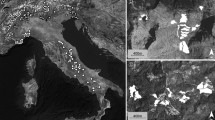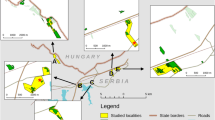Abstract
Recent studies on butterflies emphasize habitat characteristics together with metapopulation parameters (patch area and isolation) giving a more thorough understanding of processes influencing population persistence and patch occupancy, than either of them alone. We studied a coastal and an archipelago population of the Apollo butterfly (Parnassius apollo) in SW Finland. Larvae were surveyed for four years in both populations. Counting larvae on three consecutive days and temporarily removing them tested the survey accuracy. The removals showed four times higher larval abundance in the archipelago than on the coast. Survey methods were reliable, provided that empty patch status was not based on single visits only, if larval abundance was low. On the coast, large patches, and patches with high host-plant abundance were often occupied. In the archipelago, patches rich in host-plant were often occupied whereas patch area did not affect patch occupancy. In both populations, the probability of patches being occupied for three consecutive years increased with increasing host-plant abundance and patch area. Conservation of P. apollo depends on securing host-plant abundance on large enough patches in both study systems. In these systems, even crude habitat measures prove useful for understanding ecological processes behind observed patterns.
Similar content being viewed by others
References
Brommer J.E. and Fred M.S.1999. Movement of the Apollo butterfly (Parnassius apollo) related to host-plant and nectar plant patches. Ecol. Entomol.24: 125–131.
Clarke R.T., Thomas J.A., Elmes G.W. and Hochberg M.E.1997. The effects of spatial patterns in habitat quality on community dynamics within a site. Proc. R. Soc. London Ser. B264: 347–354.
Crawley M.J.1993. GLIM for Ecologists. Blackwell Science, Oxford.
Gutiérrez D., Thomas C.D. and Leon-Cortes J.L.1999. Dispersal, distribution, patch network and metapopulation dynamics of the dingy skipper butterfly (Erynnis tages). Oecologia121: 506–517.
Hanski I.1999. Metapopulation Ecology. Oxford University Press, Oxford.
Hanski I.1994. A practical model of metapopulation dynamics. J. Anim. Ecol.63: 151–162.
Hanski I. and Gilpin M.E.1997. Metapopulation Biology–Ecology, Genetics, and Evolution. Academic Press, London.
Kuussaari M., Nieminen M. and Hanski I.1996. An experimental study of migration in the Glanville fritillary Melitaea cinxia. J. Anim. Ecol.65: 791–801.
Hanski I. and Ovaskainen O.2000. The metapopulation capacity of a fragmented landscape. Nature404: 755–758
Hanski I. and Simberloff D.1997. The metapopulation approach, its history, conceptual domain, and application to conservation. In: Hanski I. and Gilpin M.E. (eds), Metapopulation Biology–Ecology, Genetics, and Evolution. Academic Press, London, pp. 5–26.
Harrison S. and Bruna E.1999. Habitat fragmentation and large-scale conservation: what do we know for sure?Ecography22: 225–232.
Harrison S. and Taylor A.D.1997. Empirical evidence for metapopulation dynamics. In: Hanski I. and Gilpin M.E. (eds), Metapopulation Biology–Ecology, Genetics, and Evolution, Academic Press, London, pp. 27–42.
Harrison S.1994. Metapopulation and conservation. In: Edwards P.J., May R.M. and Webb N. (eds), Large Scale Ecology and Conservation Biology, Blackwell Scientific Publications, London, pp. 111–128.
Harrison S., Murphy D.D. and Ehrlich P.R.1988. Distribution of the bay checkerspot butterfly Euphydryas editha bayensis: Evidence for a metapopulation model. Am. Nat.132: 360–382.
Hill J.K., Thomas C.D. and Lewis O.T.1996. Effects of habitat patch size and isolation on dispersal by Hesperia comma butterflies: implications for metapopulation structure. J. Anim. Ecol.65: 725–735.
Häyren E.1900. Längs zonerna i Ekenäs skärgård. Geografiska Föreningens Tidskrift12: 222–234.
Keyghobadi N., Rolands J. and Strobeck C.1999. Influence of landscape on the population genetic structure of the alpine butterfly Parnassius smintheus (Papilionidae). Mol. Ecol.8: 1481–1495.
Moilanen A. and Hanski I.1998. Metapopulation dynamics: effects of habitat quality and landscape structure. Ecology79: 2503–2515.
Murphy D.D., Freas K.E. and Weiss S.B.1990. An environment-metapopulation approach to population viability analysis for a threatened vertebrate. Cons. Biol.4: 41–51.
Nieminen M.1996a. Migration of moth species in a network of small islands. Oecologia108: 643–651.
Nieminen M.1996b. Risk of population extinction in moths: effect of host-plant characteristics. Oikos76: 475–484.
Porter K.1992. Eggs and egg-laying. In: Dennis R.L.H. (ed.), The Ecology of Butterflies in Britain, Oxford University Press, Oxford, pp. 46–72.
Rassi P., Alanen A., Kanerva T. and Mannerkoski I.2001. Suomen lajien uhanalaisuus 2000. Ympäristöministeriö ja Suomen Ympäristökeskus. Edita, Helsinki.
Richarz N., Neumann D. and Wipking W.1989. Untersuchungen zur ökologie des Apollofalters (Parnassius apollo vinningensis Stichel 1899, Lepidoptera, Papilionidae) im Weinbaugebiet der unteren Mosel. Mitteilungen der Arbeitsgemeinschaft rheinisch-westfälischer Lepidopterologen e.V.4: 108–259.
Roland J., Keyghobadi N. and Fownes S.2000. Alpine Parnassius butterfly dispersal: effects of landscape and population size. Ecology81: 1642–1653.
Shreeve T.G.1992. Adult behaviour. In: Dennis R.L.H. (ed.), The Ecology of Butterflies in Britain, Oxford University Press, Oxford, pp. 22–45.
Singer M.1984. Butterfly-hostplant relationships: host quality, adult choice and larval success. In: Vane-Wright R.I. and Ackery P.R. (eds), The Biology of Butterflies. Symposium of the Royal Entomological Society of London Number 11, Academic Press, London, pp. 81–88.
Thomas J.A., Bourn N.A.D., Clarke R.T., Stewart K.E., Simcox D.J., Pearman G.S., Curtis R. and Goodger B.2001. The quality and isolation of habitat patches both determine where butterflies persist in fragmented landscapes. Proc. R. Soc. London Ser. B268: 1791–1796.
Thomas J.A.1995. The ecology and conservation of Maculinea arion and other European species of large blue butterfly. In: Pullin A.S. (ed.), Ecology and Conservation of Butterflies, Chapman and Hall, London, pp. 180–197.
Vepsäläinen K., Savolainen R. and Penttinen A.1988. Causal reasoning in modeling multiway contingency tables. Oikos53: 281–285.
Wiegand T., Moloney K.A., Naves J. and Knauer F.1999. Finding the missing link between landscape structure and population dynamics: a spatially explicit perspective. Am. Nat.154: 605–627.
Wiens J.A.1997. Metapopulation dynamics and landscape ecology. In: Hanski I. and Gilpin M.E. (eds), Metapopulation Biology–Ecology, Genetics, and Evolution. Academic Press, London, pp. 43–62.
Wiklund C.1984. Egg-laying patterns in butterflies in relation to their phenology and the visual apparency and abundance of their host-plants. Oecologia63: 23–29.
Witkowski Z. and Adamski P.1996. Decline and rehabilitation of the Apollo butterfly Parnassius apollo (Linnaeus, 1758) in the Pieniny national park (Polish Carpathians). In: Settele J., Margules C.R., Poschlod P. and Henle K. (eds), Species Survival in Fragmented Landscapes, Kluwer Academic Publishers, Dordrecht, pp. 7–14.
Author information
Authors and Affiliations
Corresponding author
Rights and permissions
About this article
Cite this article
Fred, M.S., Brommer, J.E. Influence of Habitat Quality and Patch Size on Occupancy and Persistence in two Populations of the Apollo Butterfly (Parnassius apollo). Journal of Insect Conservation 7, 85–98 (2003). https://doi.org/10.1023/A:1025522603446
Issue Date:
DOI: https://doi.org/10.1023/A:1025522603446




